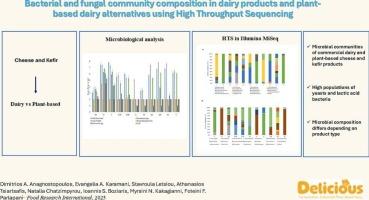使用高通量测序的乳制品和植物性乳制品替代品中的细菌和真菌群落组成
IF 8
1区 农林科学
Q1 FOOD SCIENCE & TECHNOLOGY
引用次数: 0
摘要
消费者对植物性乳制品替代品的需求日益增长,这增强了科学家对了解其微生物特性的兴趣,特别是与传统发酵乳制品相比。本研究采用经典和分子(高通量测序- HTS)方法研究了商业乳制品和植物发酵奶酪和开菲尔产品的微生物状况。经典的微生物学分析显示,在所有测试的样品中,酵母和乳酸菌(LAB)占据显著优势,在大多数情况下,酵母占主导地位,LAB共同占主导地位,特别是在植物性奶酪和kefirs中。值得注意的是,肠球菌在植物性产品中更为突出,而肠杆菌科和大肠菌群仅在一些植物性样品中检测到,这表明需要更精确的发酵控制。高通量16S rRNA基因测序显示,乳制品样品中细菌多样性相对较低,以链球菌和乳球菌为主。相比之下,植物性产品表现出更大的多样性,包括有益的科(如乳酸杆菌科)或属(如Leuconostoc)以及偶尔与腐败相关的分类群(拉乌尔氏菌、假单胞菌)。真菌分析显示,不同样品的差异很大,青霉菌在陈年奶酪中占主导地位,德巴氏菌和马拉色菌在乳制品和植物性产品中都很常见。然而,在一些植物性产品中检测到潜在的环境和/或潜在的致病真菌(例如枝孢菌,新孢子菌),反映了原材料来源和/或加工控制不足。总的来说,乳制品显示出一致的、发酵驱动的微生物群,而基于植物的样品显示出更高的微生物复杂性,包括功能性和潜在的不良微生物。研究结果强调了每种产品类型的独特微生物特征,强调了在植物发酵中需要有针对性的微生物管理和选择合适的发酵剂,以确保安全性和功能效益,支持不断增长的乳制品替代行业的创新和质量控制。这项研究为生产者、监管机构和其他利益相关者以及具有健康意识的消费者在不断发展的植物性乳制品领域提供了宝贵的知识,同时提供了值得注意的技术和科学背景,从而帮助该行业向国际贸易提供创新、安全和高质量的植物性乳制品。本文章由计算机程序翻译,如有差异,请以英文原文为准。

Bacterial and fungal community composition in dairy products and plant-based dairy alternatives using high throughput sequencing
The increasing consumer demand for plant-based dairy alternatives has enhanced scientific interest in understanding their microbiological characteristics, particularly in comparison to traditional fermented dairy products. This study investigated the microbiological status of commercial dairy and plant-based fermented cheese and kefir products, using classical and molecular (High Throughput Sequencing - HTS) approaches. Classical microbiological analysis revealed a noteworthy dominance of yeasts and lactic acid bacteria (LAB) in all samples tested, with yeasts prevailing in most cases and LAB co-dominating particularly in plant-based cheeses and kefirs. Notably, Enterococcus were more prominent in plant-based products, while Enterobacteriaceae and coliforms were detected exclusively in some plant-based samples, highlighting the need for a more precise fermentation control. High throughput 16S rRNA gene sequencing revealed a relatively low bacterial diversity in dairy samples, with Streptococcus and Lactococcus dominating. In contrast, plant-based products exhibited greater diversity, including beneficial families (e.g., Lactobacillaceae) or genera (e.g., Leuconostoc) and occasional spoilage-associated taxa (Raoultella, Pseudomonas). Fungal analysis showed high variability across samples, with Penicillium dominating aged cheese, Debaryomyces and Malassezia being common in both dairy and plant-based products. However, potential environmental and/or potential pathogenic fungi (e.g., Cladosporium, Neorysiphe) were detected in some plant-based products, reflecting raw material origin and/or insufficient processing controls. Overall, dairy products exhibited consistent, fermentation-driven microbiota, while plant-based samples showed higher microbial complexity, including both functional and potentially undesirable microorganisms. The findings emphasize the unique microbial characteristics of each product type, underscoring the need for targeted microbial management and the selection of appropriate starter culture in plant-based fermentations to ensure both safety and functional benefits, supporting innovation and quality control in the growing dairy alternative sector. This research contributes valuable knowledge for producers, regulators, and other stakeholders, as well as health-conscious consumers navigating the evolving plant-based dairy landscape, providing in parallel a noteworthy technological and scientific background, so that help the industry to provide innovative, safe and high-quality plant-based dairy products to the international commerce.
求助全文
通过发布文献求助,成功后即可免费获取论文全文。
去求助
来源期刊

Food Research International
工程技术-食品科技
CiteScore
12.50
自引率
7.40%
发文量
1183
审稿时长
79 days
期刊介绍:
Food Research International serves as a rapid dissemination platform for significant and impactful research in food science, technology, engineering, and nutrition. The journal focuses on publishing novel, high-quality, and high-impact review papers, original research papers, and letters to the editors across various disciplines in the science and technology of food. Additionally, it follows a policy of publishing special issues on topical and emergent subjects in food research or related areas. Selected, peer-reviewed papers from scientific meetings, workshops, and conferences on the science, technology, and engineering of foods are also featured in special issues.
 求助内容:
求助内容: 应助结果提醒方式:
应助结果提醒方式:


